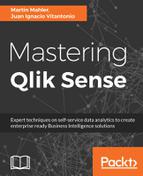If working with Qlik Sense was a swimming competition, you would consider developing mashups a freestyle discipline. You are able to implement data analytics using the Qlik Engine in any way you like—you can work in the way most comfortable to you and use the libraries which you are the most skilled in. All frameworks are available for you to use, such as the previously described AngularJS, or a different one such as Vue.js or React.
You can leverage existing Qlik Sense visualization objects or use another third party library. It is entirely up to you and, with mashups, you can build compelling web applications designed to perfection using the full power of web technology.
With freedom comes great responsibility. While you can practically achieve anything using a Qlik Mashup, there are two important caveats to this approach:
- Advanced web development skills are required to implement mashups, and in particular, around web development. If you're not from that kind of background, building mashups is not simple, needing you to upskill in JavaScript, HTML, and CSS. Coding skills are necessary rather than simple configuration skills.
- There is a lot that can go wrong, and the introduction of technical debt will become expensive in the long run. This can be in the form of performance hits, newly added functionality which is difficult to maintain, or key-person-dependencies, where the developer becomes indispensable for the continuation of the project or app.
If you are still reading the introduction to this chapter despite its caveats, you are ready to continue.
While mashups are renowned for their impressive designs and added functionalities, this chapter will not focus on that aspect of using mashups in Qlik Sense, and will not be as much of a deep-dive. That is real web development, and it would go beyond the scope of this book. There are many other titles that will enable you to upskill in those areas, and I would not be surprised to see a new title being published focusing exclusively on mashups in Qlik Sense.
Instead, this chapter will focus on getting you up to speed on working with mashups swiftly, connecting to the Qlik Engine, and creating the necessary HyperCubes, as well as passing on field selection in the underlying app.
The following is a list of topics that we will be covering in this chapter:
- Getting set up
- Connecting to the Qlik Engine
- Embedding objects
- Interacting with the Qlik Engine
